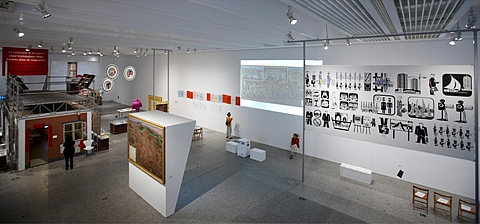Museo Nacional de Arte Reina Sofia,
May 12, 2010 - Sep 06, 2010
Madrid, Spain
The Potosí Principle
by Jaime Vindel
Principio Potosí (The Potosí Principle) is the Museo Nacional Centro de Arte Reina Sofía’s main discursive project for 2010 -the exhibition will subsequently travel to Berlin and La Paz. The project, the final result of which stems from the collaboration between Alice Creischer, Max Jorge Hinderer and Andreas Siekmann, lays out a sort of logbook throughout one of the museum’s rooms, which seeks to submerge the viewer in the muddy waters of modern-colonial reason. The focus combines a historical perspective with evidence of the persistence and mutations under which that logic currently operates. While pointing to the capital formation as the driving force behind metropolitan economies, it also reviews the hegemonic narratives of modernity, which is offset from Western enlightenment to focus on its colonial shadows instead. In this approach, linking Karl Marx to its criticism of enlightened Eurocentrism, the eighteenth century -known as the Age of Enlightenment- descends to the cellars of the imperialism that began with the symptomatically named “discovery” of America. During the “conquest” that followed that discovery, Christian ecumenism found its materialist equivalent in forced labor: the task of evangelizing established a hierarchy in the spiritual realm with the Other that the different forms of labor exploitation exacerbated in the economic realm. Homing in on this issuewith interpretative lucidity,a video by the artist of Czech origin Harun Farocki strips away the visual ideology of Descripción del Cerro Rico e Imperial Villa de Potosí (Description of Cerro Rico and the Imperial Town of Potosí), painted by Gaspar Miguel de Berrío in 1758. Although the Bolivian city of Potosí effectively symbolizes the “principle” of origin capital formation, this image speaks - through what it hides -to the opposing contrast of capitalist progress. What we see is a caravan, a wedding, a murder, an animal being sacrificed, the infrastructure created through investment in the mineral extraction of precious metals, silent signs inserted into a panoramic view of the city. The workers, however, remain absent: it is the work of Harun Farocki (in what Cuauhtémoc Medina has defined as a “work on the economic history of images”(1) and the curators of the exhibition that reminds us of the harsh smoothness of the invisible hand that, according to Adam Smith in The Wealth of Nations, turned the cogs of the incipient industrial economy. Due to the apparent silence of the image, the greatest genocide in history had to be explicitly mentioned, and the artist’s voice in off does just that.(2) Singing the Lord’s Praises in Alien Land Along with Farocki’s contribution, the other stunning moment is the two-channel screening of Marcel Expósito’s video, 143.353 (los ojos no quieren estar siempre cerrados --Eyes do not want to always be closed), the fifth chapter of the Entre Sueños. Ensayos sobre la nueva imaginación política (Between Dreams: Essays on the New Political Imagination) series. Expósito throws in the face of the Spanish public a brutal dialectic -an image of its (colonial) history. Within the framework of an economic crisis of unprecedented dimensions since its transition to democracy, Expósito delves into the process of defining the identity of that multinational entity known as Spain, which, as the artist (and activist) reminds us, has traditionally and successively been the “European bastion of the counter-Reformation, an anti-Enlightenment spirit and fascism”.(3) Thus, out of the sewers of oblivion emerged the signs of national Catholicism, which imposed a reason of exclusion - if not extermination - in its American expansion which was applied to Muslim and Jewish cultures back home. The figure of Santiago Matamoros - St. James the Moor Killer - (also converted to Santiago Mataindios - St. James the Indian Killer - in the colonized Americas) draws together the complex, multimodal narrative used by Expósito. At a certain moment, the Baroque vanitas painted by Valdés Leal (father of Lucas Valdés, author of the 1690 painting Santiago batallando con los Moros (St.James Battling the Moors displayed at the MNCARS over Expósito’s double video) in 1692 for the Church of the Hospital de la Caridad in Seville blend into the register of a much more contemporary image of the recent disinterment of the corpses of Republicans shot at the end of the Spanish Civil War. The place where they are buried is the monastery of Uclés, which was formerly occupied by the order of Santiago. The narrative spiral outlined by Expósito thus hangs over itself, questioning from the perspective of the present a society as amnesic as the Spanish, which is given to forget the deadleft on the sidelines of history by its founding ideology. In this political image of death, the allegory used as a theme by Walter Benjamin and Gilles Deleuze in a Baroque matrix comes back, weaving threads of meaning through different periods and punching holes in the strictly objective understanding of the facts. Bicentennial Tensions Expósito’s ultimate aim is to “question just how certain specific connections between power and visual representations are disseminated, while being updated in time (historical) and space (geopolitical), and topose that question just whenmost of the current nation-states in Latin America are celebrating their independence bicentennials”.(4) As the artist reminds us, the issue of the bicentennials touches upon the curatorial projects that differentmuseums are showcasing on both sides of the Atlantic.
|













